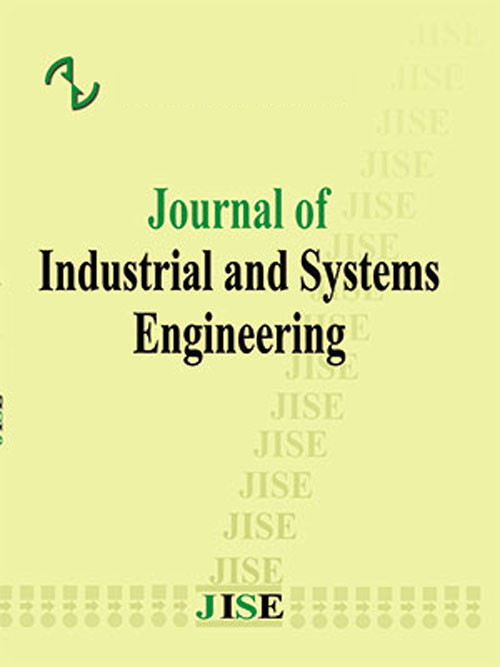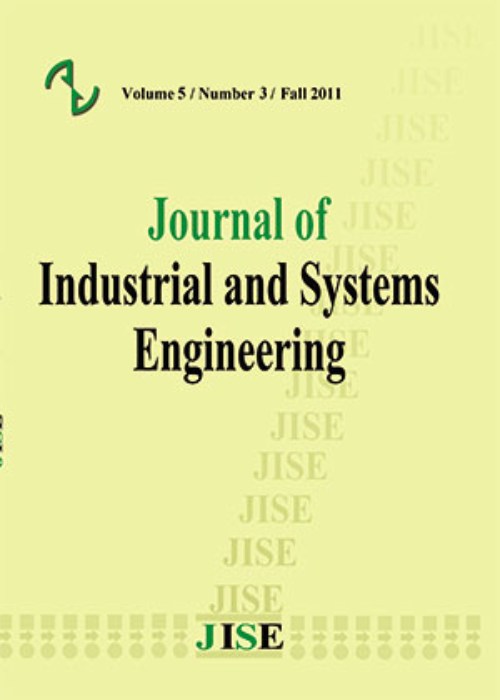فهرست مطالب

Journal of Industrial and Systems Engineering
Volume:9 Issue: 2, Spring 2016
- تاریخ انتشار: 1395/02/25
- تعداد عناوین: 7
-
-
Pages 1-19This paper addresses the Tardy/Lost penalty minimization with common due dates on a single machine. According to this performance measure, if the tardiness of a job exceeds a predefined value, the job will be lost and penalized by a fixed value. Initially, we present a 2-approximation algorithm and examine its worst case ratio bound. Then, a pseudo-polynomial dynamic programming algorithm is developed. We show how to transform the dynamic programming algorithm to an FPTAS using the technique of "structuring the execution of an algorithm" and examine the time complexity of our FPTAS.Keywords: Single machine scheduling, Tardy, Lost penalty, Common due date, Approximation algorithm, FPTAS
-
Pages 20-37Use of risk adjusted control charts for monitoring patients surgical outcomes is now popular.These charts are developed based on considering the patients pre-operation risks. Change point detection is a crucial problem in statistical process control (SPC).It helpsthe managers toanalyzeroot causes of out-of-control conditions more effectively. Since the control chart signals do not necessarily indicate the real change point of the process, in this researcha Bayesian estimation methodis applied to find the time and the size of a change in patients post-surgery death or survival outcome. The process is monitored in phase Iusing Risk Adjusted Log-likelihood Ratio Test (RALRT) chart,in whichthe logistic regression model is applied to take into accountpre-operation individual risks. Markov Chain Monte Carlo method is applied to obtain the posterior distribution of the change pointmodel including time and size of the change in the Bayesian framework and also to obtain the corresponding credible intervals. Performance evaluations of the Bayesian estimator in comparison with the maximum likelihood estimator (MLE) are conducted by means of different simulation studies. When the magnitude of the change is small, simulation results indicate superiority of the Bayesian estimator over MLE, especially when a more accurate estimation of the change point is of interest.Keywords: Risk Adjusted Control Charts, Change Point, Bayesian Estimation, Markov Chain Monte Carlo (MCMC)
-
Pages 38-53In this paper, we focus on the Data Envelopment Analysis (DEA)-based model structures have been used in assessing bank branch efficiency. Probing the methodologies of 75 published studies at the branch level since 1985 to early 2015, we found that these models can be divided into four categories: standard basic DEA models, single level and multi-level models, enriched (hybrid) models and special models. Also, summary statistics for DEA applications in bank branches from the perspectives of different measurement approaches adopted by researchers and the frequency of appearing the models of each category in the literature of discussion are derived and presented. The illustrated statistical comparisons show that the popularity of multi-level models than the single level models are on the rise. Furthermore, as a result, we can conclude that from the perspective of performance measurement approaches applied to bank branches, the production approach is more widely used than the others.Keywords: Bank branch, Data envelopment analysis, Efficiency, model structures
-
Pages 54-66A new mathematical model based on the alternative process routings in presence of a queuing system in a dynamic cellular manufacturing system has been proposed in this paper.This model integrates two problems of cell formation and inter-cell layout and also an efficiency factor which is defined for minimizing the cell load variation through the maximizing the busy time for all machine types. In order to evaluate the performance of proposed model, some numerical examples are generated randomly and solved using GAMS optimization software suitable for MIP and MINLP models. The Baron solver which is capable of solving both linear and nonlinear model is implemented. Experimental results verify the applicability of proposed model in every industrial plant which implements a CMS. Moreover, based on the sensitivity analysis, the queue system has significant impact on overall system efficiency. In other words by increasing the part arrival rate the machine busy time is increased strictly.Keywords: queuing theory, cellular manufacturing system, machine breakdown, Reliability
-
Pages 67-87The purpose of this article is to present an optimization model for designing an acceptance sampling plan based on cumulative sum of run length of conforming items. The objective is to minimize the total loss including both the producer and consumer losses. The concept of minimum angle method is applied to consider producer and consumer risks in the optimization model. Also the average number of inspection is considered in the constraint of the model.A practical case study is solved and a sensitivity analysis is performed for elaborating the effect of some important parameters on the objective function. The results of sensitivity analysis showed that the proposed model performance is logical, reliable in all the cases and also has better performance in comparison with classical method in most of the cases. A computational experiment is done to compare the different sampling schemes. The results of computational experiment showed that the proposed model has better performance due to smaller ANI value in all cases.Keywords: Quality control, Conforming run length, Acceptance Sampling Plan, Minimum angle method, Taguchi loss function
-
Pages 88-101In recent years, great efforts have been made to reduce greenhouse gas emissions by vehicles. Petroleum products produces greenhouse gas emissions, therefore reducing the use of these products can make a major contribution to reducing pollution. The Fleet Size and Mix Vehicle Routing Problem is one of the most widely used routing branches. In this problem, there are vehicle with different capacities and there is the possibility of choosing vehicles of different types. In this paper, Fleet Size and Mix Vehicle Routing Problem is death considering the reduction of fuel consumption. Since this problem is NP-hard, three novel heuristic methods entitled GROS-I,GROS-II, GGT are presented for the problem. In order to evaluate the proposed heuristics a number of small, medium and large problems are solved. The results show that proposed algorithms have good performance.Keywords: Mix vehicle routing, reduction of fuel consumption, heuristics, green vehicle routing problem
-
Pages 102-112The competitive vehicle routing problem is one of the important issues in transportation area. In this paper a new method for competitive VRP with time windows and stochastic demand is introduced. In the presented method a three time bounds are given and the probability of arrival time between each time bound is assumed to be uniform. The demands of each customer are different in each time window. Therefore, revenue given in each time window is different. In this paper a project with two companies in a city with eight customers is considered and the best routing with maximum revenue is obtained.Keywords: Competitive VRP, Time window, stochastic demand, Mathematical Model


